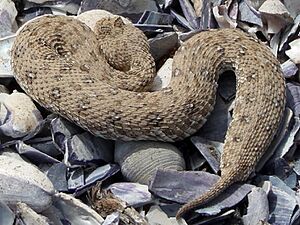Bitis schneideri facts for kids
Quick facts for kids Bitis schneideri |
|
|---|---|
 |
|
| Conservation status | |
| Scientific classification | |
| Genus: |
Bitis
|
| Species: |
schneideri
|
| Synonyms | |
|
|
The Namaqua dwarf adder (scientific name: Bitis schneideri) is a very small venomous snake. It belongs to the Viperidae family, which includes many types of vipers. This snake lives in a specific coastal area. This area is found on the border between Namibia and South Africa. It is the smallest snake in its group, called Bitis. It might even be the smallest viper in the whole world! People also call it the spotted dwarf adder or Schneider's adder.
Contents
What's in a Name?
The scientific name for this snake is schneideri. It was named by a scientist named Oskar Boettger. He chose this name to honor his friend, Dr. Oskar Schneider. Dr. Schneider lived in Dresden and was interested in studying shells and snails.
How Small is the Namaqua Dwarf Adder?
This snake is truly tiny! On average, it grows to be about 18 to 25 centimeters (7 to 10 inches) long. The longest one ever found was about 28 centimeters (11 inches). This makes it the smallest snake in the Bitis group. It is also possibly the smallest viper known.
Where Does This Snake Live?
The Namaqua dwarf adder lives in a special place. Its home is along the white coastal sand dunes. This area stretches from Lüderitz in Namibia. It goes south to Hondeklip Bay in Namaqualand, South Africa.
Its Unique Coastal Home
The snake's habitat is a narrow strip of coastal dunes. This area has very stable temperatures. This means there isn't much difference between seasons. The snake's range might even go up to 60 kilometers (37 miles) inland. This happens in a place called the Sperrgebiet in southern Namibia.
How Does the Namaqua Dwarf Adder Live?
These small snakes face many dangers in their environment. Many predators hunt them because of their tiny size. Because of this, a large number of them (about 39–56%) die each year.
Raising Young Snakes
To make up for this, the Namaqua dwarf adder reproduces more often. They have babies once every year. This is different from many other vipers. Most vipers only have babies every other year or even less often. These snakes give birth to live young. This means the babies hatch inside the mother and are born alive.
What Happens if You Get Bitten?
A person named Hurrell shared his experience after being bitten. He was bitten on his left index finger. The bite caused strong pain and swelling. The area also changed color, and some fluid came out.
Bite Symptoms and Recovery
After a day, a small bruise formed where the bite happened. His condition got better after three to four days. The swelling and pain slowly went away. He was completely healed after two weeks. There was no lasting damage or loss of feeling in his finger. The bite caused only minor local damage. It did not affect his whole body. There is no special medicine (antivenom) for this snake's bite.


